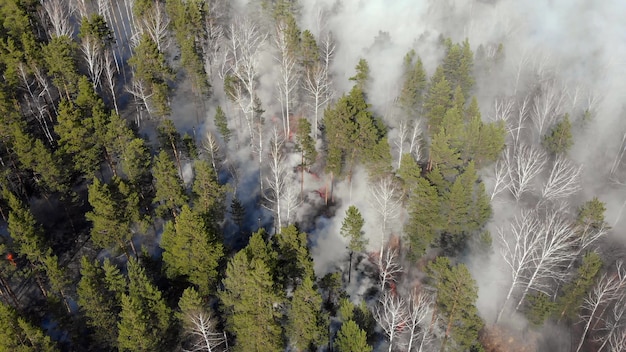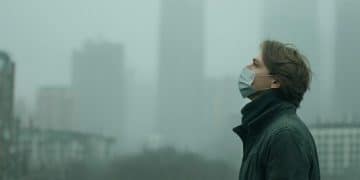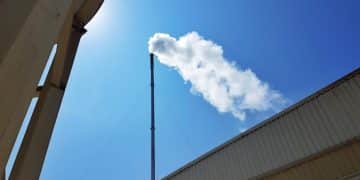Wildfires’ Long-Term Impact: Air Quality & US Public Health

Advertisements
Wildfires significantly degrade long-term air quality, exposing US populations to fine particulate matter and hazardous air pollutants, leading to chronic respiratory, cardiovascular, and neurological illnesses, alongside mental health issues and increased healthcare demands, particularly impacting vulnerable communities.
Advertisements
The escalating frequency and intensity of wildfires across the United States are transforming landscapes and captivating headlines. Yet, beyond the immediate devastation lies a more insidious threat: the lingering, long-term impact of wildfire smoke on both air quality and public health. Understanding what are the long-term effects of wildfires on air quality and public health in the US is crucial as these events become an increasingly pervasive aspect of our climate reality.
Understanding Wildfire Smoke Composition and Its Reach
Wildfire smoke is a complex concoction, far more than just visible fumes. It’s a dynamic mix of gases and fine particulate matter, primarily PM2.5, which are tiny particles less than 2.5 micrometers in diameter. These particles are small enough to be inhaled deep into the lungs and even enter the bloodstream, posing significant health risks. It’s critical to grasp the intricacies of this composition and how widely it can spread to truly understand its long-term implications.
Beyond PM2.5, wildfire smoke contains a cocktail of hazardous air pollutants, including volatile organic compounds (VOCs) like benzene and formaldehyde, carbon monoxide, nitrogen oxides, and polycyclic aromatic hydrocarbons (PAHs). The exact composition varies depending on the type of vegetation burning, the stage of combustion, and wind patterns, making each smoke plume uniquely dangerous.
Advertisements
The Invisible Threat: Particulate Matter (PM2.5)
Among the various components of wildfire smoke, PM2.5 is often cited as the most dangerous due to its size and ability to penetrate deep into the respiratory system. These microscopic particles are not easily filtered by bodily defenses, bypassing nasal hairs and mucous membranes. Their small size allows them to bypass the body’s natural defenses, leading to prolonged exposure and systemic inflammation.
- Inhalation: PM2.5 can reach the deepest parts of the lungs, including the alveoli, where oxygen exchange occurs.
- Systemic Entry: Once in the alveoli, these particles can cross the lung-blood barrier, entering the bloodstream and circulating throughout the body.
- Organ Impact: This systemic circulation allows PM2.5 to affect various organs far beyond the respiratory system, including the heart, brain, and kidneys.
The spread of wildfire smoke is also a critical factor in its long-term impact. Strong winds can carry smoke plumes thousands of miles from their origin. This means that residents far from active fire zones can still experience significant reductions in air quality, sometimes weeks after a fire has been contained. Atmospheric conditions, such as inversions, can trap smoke close to the ground, concentrating pollutants and exacerbating exposure for local communities. The long-range transport of smoke makes it a nationwide public health concern, not just a regional issue. Understanding the physics of smoke dispersion is key to predicting its reach and preparing communities.
The scale of smoke plumes can be immense, blanketing vast geographical areas and affecting millions of people simultaneously. This widespread exposure means that the long-term effects are not confined to fire-prone states but extend across the entire US, impacting a diverse range of urban and rural populations. The persistent nature of smoke, sometimes lasting for weeks or even months during prolonged fire seasons, compounds the risk, leading to chronic low-level exposure even when fires are not actively raging. Such prolonged exposure disrupts daily life, forcing people indoors and limiting physical activity, which can have its own independent health consequences, particularly for children and the elderly.
Chronic Respiratory Health Consequences
The respiratory system bears the brunt of wildfire smoke exposure. While immediate effects like coughing and shortness of breath are well-documented, the long-term health consequences are more insidious, contributing to a range of chronic respiratory conditions. Prolonged or repeated exposure can fundamentally alter lung function and increase susceptibility to future ailments, particularly for vulnerable populations.
One of the most significant long-term effects is the exacerbation of pre-existing respiratory conditions such as asthma and chronic obstructive pulmonary disease (COPD). For individuals already suffering from these conditions, repeated exposure to smoke can trigger severe flare-ups, leading to increased emergency room visits and hospitalizations. The inflammation induced by PM2.5 and other pollutants can cause airways to constrict, making breathing difficult and leading to persistent symptoms long after the smoke clears. This chronic irritation can accelerate disease progression and diminish overall quality of life.

Asthma and COPD Exacerbation
Studies have shown a clear link between wildfire smoke exposure and increased risk of asthma attacks and COPD exacerbations. The fine particulate matter irritates the airways, causing inflammation and bronchoconstriction. For asthmatics, this can mean more frequent and severe attacks, sometimes requiring stronger medication or even intubation in extreme cases. For COPD patients, the damage to lung tissue can become irreversible, leading to a permanent decline in lung function and increased morbidity.
- Increased Symptoms: Patients report more coughing, wheezing, and shortness of breath.
- Medication Dependence: Greater reliance on rescue inhalers and oral corticosteroids.
- Hospitalizations: Higher rates of emergency department visits and inpatient admissions.
Beyond exacerbating existing conditions, there is growing evidence that long-term exposure to wildfire smoke can contribute to the development of new respiratory problems in previously healthy individuals. This is particularly concerning for children, whose lungs are still developing, and outdoor workers who experience extended periods of exposure. Chronic inflammation and oxidative stress induced by smoke can lead to structural changes in lung tissue, increasing the risk of developing conditions like chronic bronchitis, emphysema, and reduced lung capacity over time. The cumulative impact means that even low-level, but persistent, exposure can chip away at lung health over decades. This delayed onset of symptoms makes it challenging to attribute chronic conditions solely to wildfire smoke, underscoring the need for long-term epidemiological studies and proactive public health measures.
Pulmonary fibrosis, a condition characterized by scarring of lung tissue, is another potential long-term consequence. While typically associated with genetic factors or occupational exposures, chronic inflammation from pollutants like those found in wildfire smoke can promote fibrotic changes. This scarring reduces lung elasticity and gas exchange efficiency, leading to progressive shortness of breath and an irreversible decline in lung function. The severity of these long-term respiratory effects is often dose-dependent, meaning that individuals in regions with frequent and intense wildfire seasons are at a higher risk of experiencing significant and lasting lung damage.
Cardiovascular Impact and Risk
The reach of wildfire smoke extends far beyond the lungs, significantly impacting the cardiovascular system. The fine particulate matter, once it enters the bloodstream, triggers systemic inflammation and oxidative stress, laying the groundwork for a range of long-term cardiac problems. This makes understanding the cardiovascular ramifications a critical component of assessing the long-term effects of exposure.
One of the primary concerns is the increased risk of heart attacks and strokes. PM2.5 can promote arterial stiffness and increase blood viscosity, making it easier for clots to form. Individuals with pre-existing cardiovascular conditions, such as hypertension, coronary artery disease, or a history of heart failure, are particularly vulnerable. For them, sustained exposure to smoke can hasten the progression of their disease, leading to more frequent cardiovascular events, hospitalizations, and a higher risk of mortality. The disruption to the autonomic nervous system, which regulates heart rate and blood pressure, also contributes to this increased risk, often leading to arrhythmias.
Chronic exposure to air pollution, including wildfire smoke, is also linked to the development and progression of atherosclerosis, a condition where plaque builds up inside the arteries, narrowing them and making them less flexible. This process occurs silently over many years but can be accelerated by persistent inflammatory responses triggered by smoke components. The consistent irritation and damage to the inner lining of blood vessels facilitate cholesterol deposition and plaque formation, increasing the risk of future cardiovascular events.
Heart Failure and Arrhythmias
For those already battling heart failure, wildfire smoke presents a formidable challenge. The increased burden on the heart, coupled with systemic inflammation, can lead to decompensation and worsening of symptoms. Similarly, arrhythmias, or irregular heartbeats, can be triggered or exacerbated by smoke exposure, posing a risk of sudden cardiac events.
- Increased Blood Pressure: Short-term spikes can become chronic elevation with prolonged exposure.
- Endothelial Dysfunction: Damage to the inner lining of blood vessels, impairing their ability to dilate and constrict.
- Increased Coagulation: Higher risk of blood clot formation, leading to heart attacks or strokes.
The cumulative effects of repeated exposure to wildfire smoke can lead to structural changes in the heart itself. Chronic inflammation and oxidative stress can contribute to myocardial remodeling, where the heart muscle increases in thickness or changes shape. These changes can impair the heart’s pumping efficiency, leading to a gradual decline in cardiac function over time. Such structural changes may manifest as a progressive decline in exercise tolerance, persistent fatigue, and an increased susceptibility to further cardiovascular events. The long latency period for some of these effects makes it challenging to draw direct causal links without extensive longitudinal studies, yet the mechanistic pathways are increasingly clear.
Beyond heart attacks and strokes, sustained exposure is also associated with an increased incidence of microvascular dysfunction, affecting the tiny blood vessels that supply blood to various organs. This can contribute to issues such as kidney damage, brain impairment, and general systemic dysfunction. The multifaceted impact on the cardiovascular system underscores the broad physiological disruption caused by wildfire smoke, extending its reach far beyond the direct act of breathing. Healthcare systems in fire-prone regions face mounting pressure from the long-term care needs of patients with smoke-induced cardiovascular ailments.
Neurological and Mental Health Impacts
While visibility and breath are the immediate concerns, the long-term effects of wildfire smoke extend to the brain and mental well-being, presenting a complex interplay of physical and psychological challenges. The insidious nature of air pollution means its impact on cognitive function and mental health can be subtle, yet profound, accumulating over time.
Neurological effects stem from the ability of fine particulate matter and other pollutants to cross the blood-brain barrier. Once in the brain, these particles can induce neuroinflammation and oxidative stress, potentially accelerating neurodegenerative processes. Studies have begun to link long-term ambient air pollution exposure to an increased risk of cognitive decline, dementia, and even Parkinson’s disease. While direct, long-term studies specifically on wildfire smoke are still emerging, the parallels with other forms of air pollution suggest similar mechanisms of damage. Children and the elderly are particularly susceptible, with potential impacts on neurodevelopment in the young and accelerated cognitive decline in older adults. This makes the cognitive burden a silent, yet significant, component of wildfire impact.

Cognitive Decline and Stroke Risk
The brain’s delicate environment is vulnerable to systemic inflammation. While acute smoke exposure might lead to headaches or dizziness, chronic exposure raises more concerning questions. Sustained neuroinflammation can impair neuronal function, affecting attention, memory, and executive functions. Furthermore, the increased risk of stroke from cardiovascular impacts also has direct neurological consequences, leading to potential long-term disability and cognitive impairment.
- Neuroinflammation: Chronic activation of immune cells in the brain, potentially damaging neurons.
- Oxidative Stress: Imbalance between free radicals and antioxidants, leading to cellular damage.
- Accelerated Aging: Possible contribution to premature brain aging and neurodegeneration.
Beyond the direct physiological effects on the brain, the mental health implications of long-term wildfire smoke exposure are substantial and often overlooked. Prolonged periods of poor air quality force people indoors, leading to social isolation, reduced physical activity, and disruptions to daily routines. The constant visual reminder of hazy skies and the pervasive smell of smoke can create a sense of anxiety, chronic stress, and helplessness. For communities directly impacted by fires, the trauma of displacement, loss of property, and disruption of livelihoods exacerbates these mental health challenges, leading to higher rates of depression, anxiety disorders, and post-traumatic stress disorder (PTSD). Children are especially vulnerable, as prolonged disruption can interfere with their development and education.
The compounding effect of physical health deterioration and psychological distress creates a vicious cycle. Individuals struggling with respiratory or cardiovascular issues due to smoke exposure may experience increased anxiety about their health, which in turn can worsen their physical symptoms. The erosion of community well-being, coupled with the economic strain of fire recovery and healthcare costs, further perpetuates this stress. Addressing the long-term mental health footprint of wildfires requires robust community support systems, accessible mental health services, and a recognition of the pervasive psychological trauma that extends far beyond the fire season itself. The invisible burden on the mind is as critical as the visible toll on the lungs.
Vulnerable Populations and Disproportionate Impacts
The long-term effects of wildfire smoke are not uniformly distributed across the population. Certain groups bear a disproportionate burden due to a combination of physiological vulnerabilities, socioeconomic factors, and geographical proximity to fire-prone areas. Recognizing these disparities is essential for developing equitable public health strategies.
Children are among the most vulnerable. Their respiratory systems are still developing, and they breathe more air per pound of body weight than adults, leading to a higher dose of pollutants for a given concentration. Long-term exposure during critical developmental windows can result in compromised lung function, an increased risk of developing asthma, and altered immune responses that may persist throughout their lives. Schools in affected areas also face challenges, with school closures impacting education and potentially increasing indoor exposure if ventilation systems are inadequate. The long-term educational and health disparities create a ripple effect, exacerbating disadvantage.
The elderly are another high-risk group. With weakened immune systems, pre-existing health conditions (such as cardiovascular or respiratory diseases), and reduced physiological reserves, they are less resilient to the insults of chronic smoke exposure. This can lead to more severe exacerbations of existing illnesses, increased hospitalizations, and a higher risk of premature mortality. Limited mobility or social isolation can also hinder their ability to seek shelter or access clean air, further compounding their vulnerability during smoke events.
Socioeconomic Factors and Environmental Justice
Socioeconomic status plays a critical role in determining exposure and resilience. Low-income communities and communities of color are often disproportionately affected by wildfires. They may live in areas closer to fire zones, lack access to adequate housing with good air filtration, or have limited resources to evacuate or purchase protective equipment like N95 masks. These communities may also have poorer baseline health due to systemic inequalities, making them more susceptible to the adverse effects of smoke.
- Housing Quality: Older homes with poor sealing and ventilation offer less protection from outdoor smoke.
- Access to Healthcare: Limited access to specialized care or preventative treatment for chronic conditions.
- Occupational Exposure: Outdoor workers (e.g., agricultural, construction) face elevated and prolonged exposure.
Indigenous communities also face unique and pressing challenges. Many Indigenous lands and communities are located in remote, fire-prone regions, and traditional land management practices, which historically included controlled burns, have been suppressed, leading to more severe wildfires. These communities often rely on traditional food sources and practices that are disrupted by fires and smoke. Furthermore, the cultural and spiritual ties to the land are deeply impacted by the destruction of ancestral territories, leading to intergenerational trauma and mental health burdens that extend far beyond physical ailments. The cumulative impacts on cultural practices, food security, and mental well-being represent a profound long-term cost.
The cumulative burden on these vulnerable populations highlights significant environmental justice issues. Addressing the long-term effects of wildfires requires not just broad public health interventions but also targeted strategies that acknowledge and mitigate these disproportionate impacts. This includes investing in community resilience, ensuring equitable access to clean air refuges, improving housing quality in at-risk areas, and providing culturally sensitive health services. Without such considerations, the health disparities caused by wildfires will only widen, further entrenching systemic inequalities.
Economic and Healthcare System Burdens
The long-term effects of wildfires on air quality and public health extend beyond individual suffering, imposing substantial economic and healthcare system burdens across the United States. These costs are multifaceted, ranging from direct medical expenses to lost productivity and infrastructure damage, creating a complex web of financial and operational challenges.
Healthcare systems face increased demand for services, particularly during and after wildfire seasons. Emergency rooms see a surge in patients presenting with respiratory distress, cardiovascular events, and other smoke-related ailments. Hospitals experience higher admission rates for chronic conditions exacerbated by air pollution. This rise in patient volume strains resources, including staff, beds, and specialized equipment, leading to longer wait times and potentially compromised care for all patients. The long-term increase in chronic respiratory and cardiovascular diseases also translates into higher costs for ongoing medication, specialist consultations, and rehabilitative therapies. Insurance companies and public health programs bear a significant portion of these mounting medical expenses.
Rising Healthcare Costs and Productivity Losses
The financial toll of wildfire smoke is substantial. Beyond direct treatment costs, there are indirect economic impacts such as lost productivity due to illness, absenteeism from work or school, and reduced outdoor labor capacity. Businesses, especially those reliant on tourism or outdoor activities, also suffer significant revenue losses during prolonged smoke events. The cumulative effect is a drag on regional and national economies.
- Medical Services: Increased demand for emergency care, hospitalizations, and specialist visits.
- Medication Expenses: Higher prescription costs for managing chronic respiratory and cardiovascular conditions.
- Lost Workdays: Employees miss work due to illness or caring for affected family members.
Infrastructure, too, is indirectly impacted. While direct fire damage to structures is easily quantifiable, the long-term effects on public health infrastructure are more subtle. Air quality monitoring networks need expansion and maintenance. Public health departments require increased funding for surveillance, community outreach, and the dissemination of clean air strategies. Furthermore, the need for clean air shelters and improved indoor air quality in public buildings adds to the financial burden on municipalities. Investment in these areas is crucial for building resilience but places additional strain on public budgets already stretched by fire suppression costs and recovery efforts.
The economic burden also includes property value depreciation in areas frequently affected by smoke, disincentivizing investment and potentially leading to outward migration. This can create “smoke-stricken” areas, further exacerbating economic disparities. The tourism industry often suffers, as hazy skies and health warnings deter visitors, leading to job losses and reduced local tax revenues. The long-term impact on agriculture, particularly in regions where smoke affects crop yields or livestock health, also presents a significant economic challenge. These costs, both direct and indirect, demonstrate that the impact of wildfires is a comprehensive economic shock that demands multi-sectoral planning and investment to mitigate its long-term financial consequences and protect community well-being.
| Key Aspect | Brief Description |
|---|---|
| 💨 Air Quality Degradation | Persistent PM2.5 and harmful pollutants spread widely, affecting vast regions long after fires subside. |
| 🫁 Chronic Respiratory Ailments | Increased asthma, COPD exacerbations, and even new onset of respiratory diseases from prolonged exposure. |
| ❤️ Cardiovascular Health Risks | Elevated risk of heart attacks, strokes, and worsening heart failure due to systemic inflammation. |
| 🧠 Mental & Neurological Issues | Cognitive decline, increased anxiety, depression, and PTSD, especially in vulnerable communities. |
Frequently Asked Questions
▼
The primary culprit is fine particulate matter (PM2.5), which can penetrate deep into the lungs and bloodstream. Wildfire smoke also contains hazardous gases like carbon monoxide, volatile organic compounds (VOCs) such as benzene and formaldehyde, nitrogen oxides, and polycyclic aromatic hydrocarbons (PAHs), all of which contribute to chronic health problems through prolonged exposure.
▼
Strong winds can carry smoke plumes thousands of miles from their origin. Atmospheric conditions, such as temperature inversions, can trap smoke closer to the ground, concentrating pollutants. These meteorological factors allow smoke to blanket vast geographical areas, affecting air quality and public health far from the actual fire zones in the US.
▼
While wildfire smoke undeniably exacerbates existing conditions like asthma and COPD, there is growing evidence it can cause new health problems. Chronic inflammation and oxidative stress from prolonged exposure may lead to the development of chronic bronchitis, reduced lung capacity, accelerated atherosclerosis, and even contribute to cognitive decline in previously healthy individuals.
▼
Children, whose lungs are still developing, and the elderly, with often compromised immune and cardiovascular systems, are highly vulnerable. Additionally, low-income communities, communities of color, and outdoor workers disproportionately bear the burden due to factors like housing quality, limited healthcare access, and increased occupational exposure, highlighting environmental justice concerns.
▼
The long-term health effects lead to significant economic burdens, including increased healthcare costs from rising chronic illness rates, lost productivity due to illness and absenteeism, and decreased tourism revenue. Local economies suffer from reduced outdoor activity and potential property value depreciation. This creates strain on public health services and broader economic stability, requiring ongoing financial investment.
Conclusion
The long-term effects of wildfires on air quality and public health in the US represent a profound and escalating challenge, extending far beyond the immediate devastation of flames. As wildfire seasons intensify, a complex blend of fine particulate matter and hazardous gases infiltrates communities, leading to insidious, cumulative health impacts. From chronic respiratory ailments like exacerbated asthma and COPD to increased cardiovascular events such as heart attacks and strokes, the physiological toll is substantial. Moreover, mounting evidence points to significant neurological and mental health burdens, including cognitive decline, anxiety, and PTSD. These effects are not distributed equally, disproportionately afflicting vulnerable populations like children, the elderly, and socioeconomically disadvantaged communities. The resultant strain on healthcare systems and broader economic productivity underscores the far-reaching consequences of a changing climate. Addressing this silent crisis demands a multi-faceted approach, emphasizing robust public health interventions, equitable access to resources, and comprehensive strategies for air quality management and climate resilience to safeguard the well-being of future generations.





